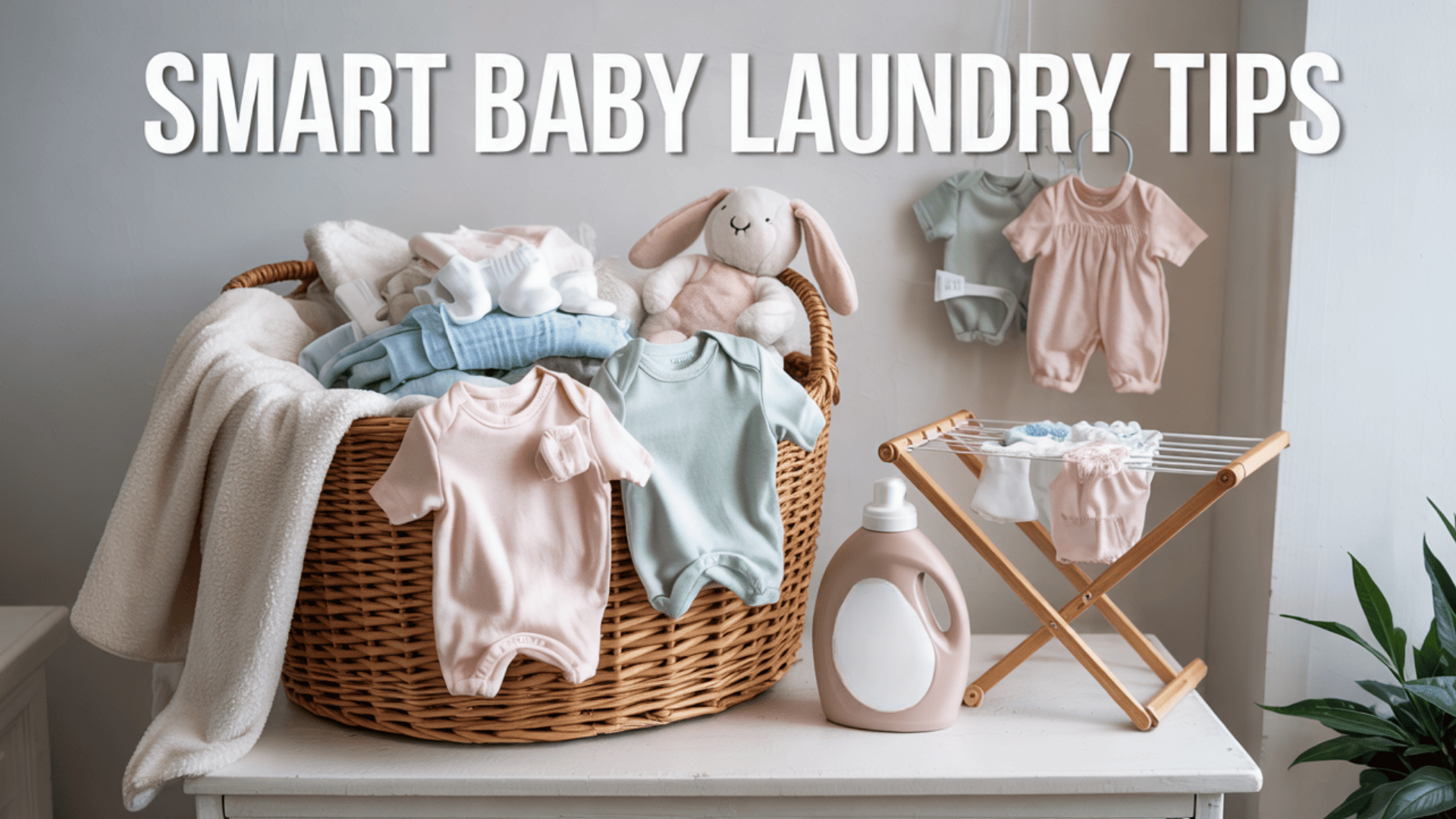
Are you confused about why your baby’s perfect outfit caused an unexpected rash? The culprit might be hiding in how you wash those adorable onesies!
Your newborn’s skin is up to 5 times thinner than yours, making it ultra-vulnerable to hidden chemicals and detergent residues lurking in their clothes. One wrong washing method could mean the difference between peaceful sleep and an uncomfortable, fussy baby.
This ultimate baby laundry guide reveals the essential secrets most parents learn too late.
From pre-washing must-knows to conquering stubborn breast milk stains that seem impossible to remove, we cover every aspect of baby clothing care.
Learn time-saving laundry hacks for sleep-deprived parents and master techniques that preserve those precious outfits through countless washes.
Alter your laundry routine with our expert tips and give your baby the gentle, irritant-free clothing their sensitive skin deserves!
Why You Should Pre-Wash Baby Clothes?
Pre-washing your baby’s new clothes is an essential step before dressing your little one. New garments often contain manufacturing chemicals, residual dyes, and preservatives that could irritate your baby’s sensitive skin.
While invisible to the eye, these substances may cause rashes or discomfort when they come into contact with your newborn’s sensitive skin.
Pre-washing removes these potential irritants and simultaneously softens the fabric. Baby clothing, especially organic options, can feel stiff initially but become gentle and cozy after washing. This simple step creates a more comfortable experience for your baby.
Additionally, pre-washing eliminates dust, allergens, and germs that may have accumulated during production or while displayed in stores.
This precaution is particularly important for babies with sensitive skin or allergies. For this important first wash, a gentle, fragrance-free detergent specifically formulated for babies is recommended.
What You’ll Need: Essential Supplies
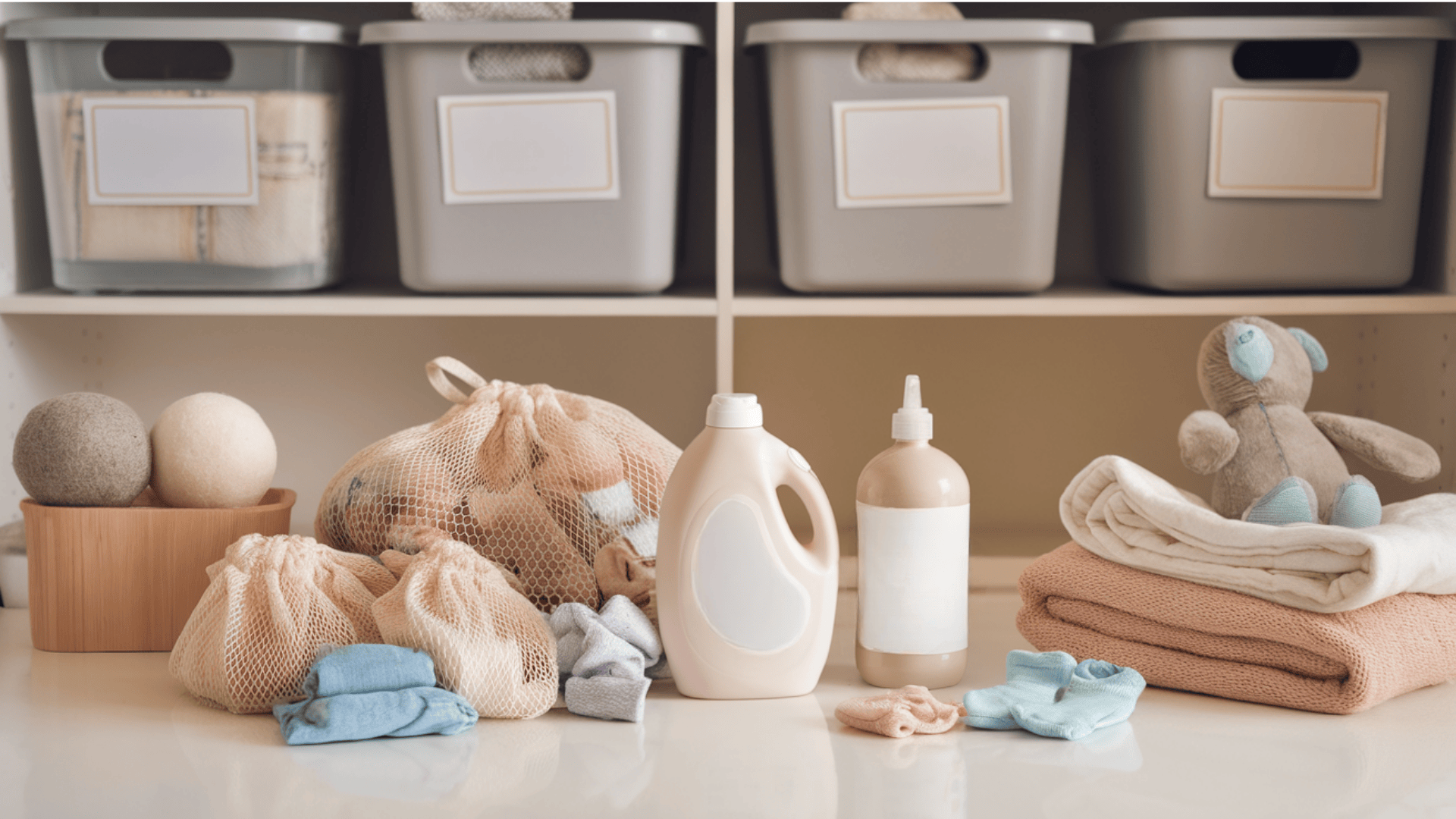
Before washing your baby’s clothes, gather these key items to ensure safe, effective cleaning while protecting fine fabrics and your little one’s sensitive skin.
1. Baby-Friendly Detergents
Choose fragrance-free, hypoallergenic detergents specifically formulated for sensitive skin. Look for options free from dyes, phosphates, and harsh chemicals that might irritate your baby’s sensitive skin.
2. Gentle Stain Removers
Opt for enzyme-based stain removers that break down proteins without harsh chemicals. Plant-based options work well on common baby stains like formula, breast milk, and diaper accidents.
3. Mesh Laundry Bags
Use these to protect fine items like socks, mittens, and headbands from getting lost in the wash or damaged by friction with rougher fabrics.
4. Dryer Balls
These natural wool alternatives to dryer sheets reduce static and wrinkles while decreasing drying time—without introducing chemicals to your baby’s clothes.
5. Laundry Sorting Bins
Designate separate hampers for heavily soiled items versus lightly worn clothes to streamline your washing routine and ensure proper cleaning.
How to Prepare for Baby’s Arrival?
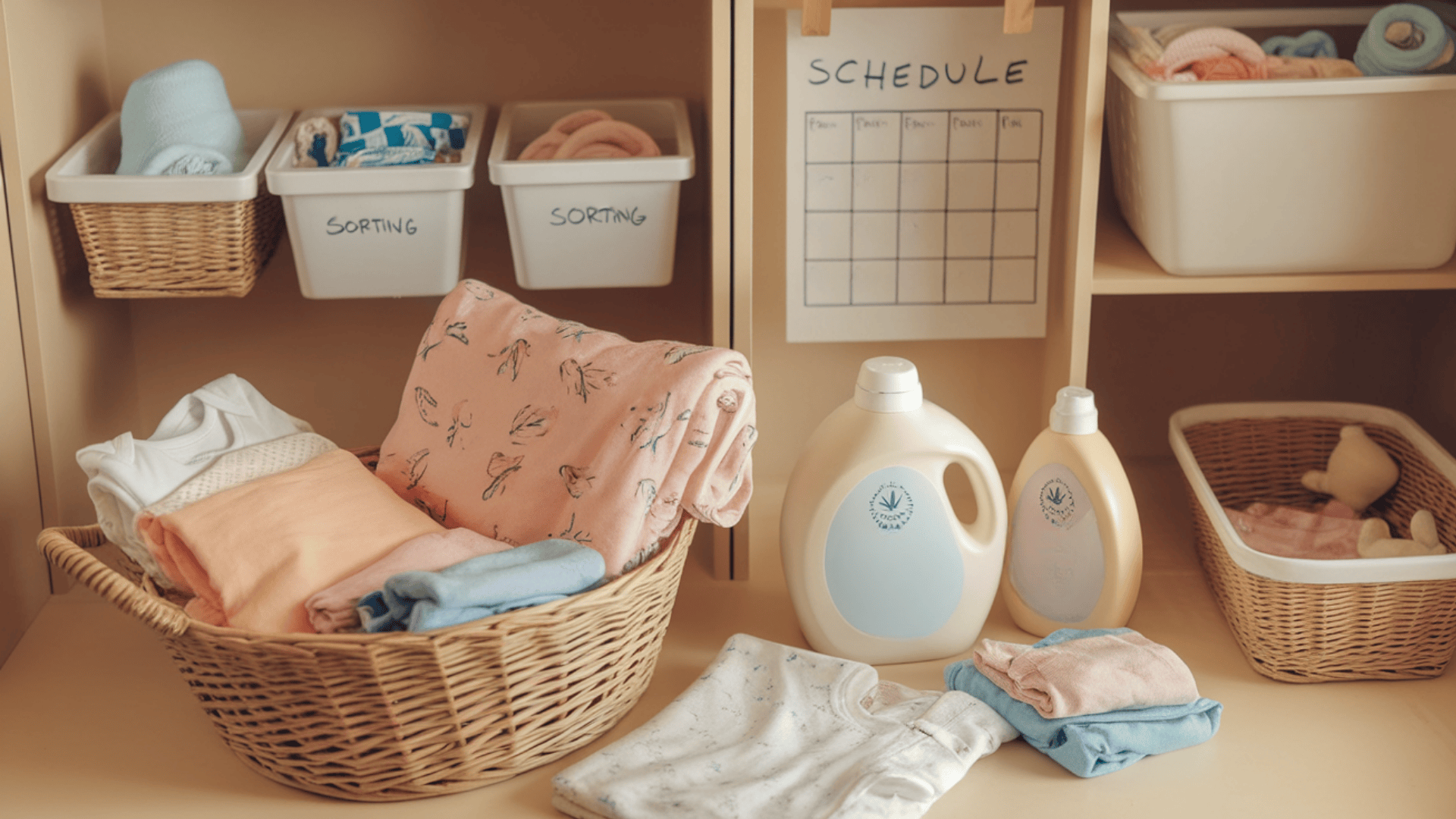
Before bringing your newborn home, pre-wash essential items that will have direct contact with their skin. Prioritize washing onesies, sleepers, swaddles, crib sheets, burp cloths, and receiving blankets at least 1-2 weeks before your due date.
Create a simple washing schedule by doing small loads every 2-3 days rather than waiting for laundry to accumulate. This prevents overwhelming piles and ensures that clean clothes are always available.
Set up a designated laundry station in an accessible location with your baby-safe detergent, stain remover, and sorting bins.
Keep a small basket in the nursery for soiled items and consider placing pre-treatment supplies nearby for immediate spot cleaning of inevitable messes.
First-Time Washing Guide
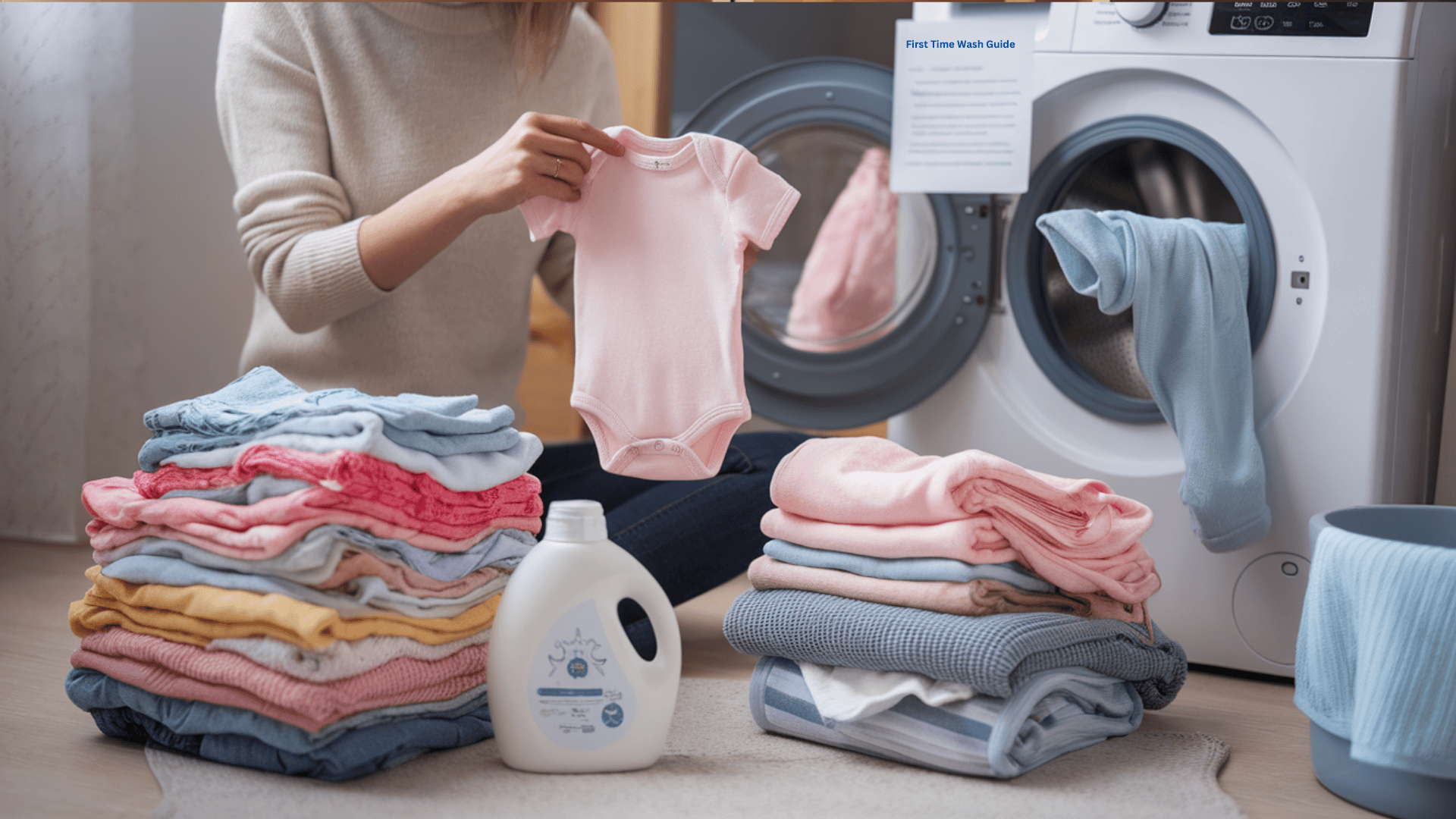
When washing baby clothes for the first time, separate items by color and fabric type to prevent dye transfer or damage to fine materials. Turn garments inside out to protect prints and reduce friction on seams and decorative elements.
Use a gentle cycle with cold or warm water—never hot, as this can shrink fabrics and set stains.
Add only a small amount of baby-safe detergent; excess soap can irritate sensitive skin and is difficult to rinse out completely. An extra rinse cycle helps ensure that all detergent residue is removed.
Always check the care labels before washing. These provide crucial information about water temperature, drying methods, and special instructions for that specific item.
Some fine pieces may require hand washing, while others might need to avoid the dryer altogether.
For natural fabrics like cotton, pre-shrinking is beneficial before your baby wears them, ensuring proper fit after subsequent washes.
Machine Washing Baby Clothes
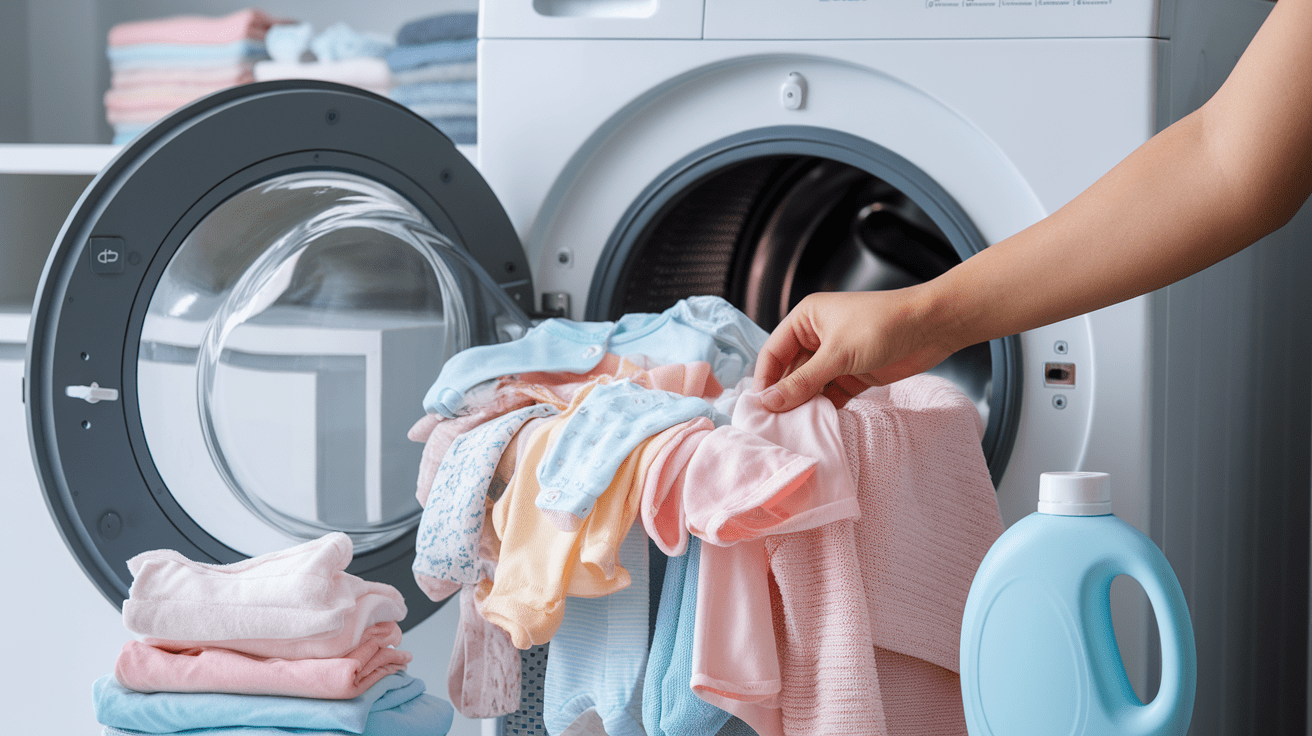
Proper machine washing techniques help maintain the softness, shape, and safety of your baby’s clothing while effectively removing stains and bacteria that can accumulate throughout the day
1. Temperature Settings
Wash most baby clothes in cold to warm water (30-40°C/85-105°F) to remove protein-based stains without causing shrinkage.
Reserve hot water only for heavily soiled items or when sanitizing cloth diapers, as high heat can damage fine fabrics and set stains.
2. Detergent Amounts
Use significantly less detergent than recommended—typically half the suggested amount is sufficient. Baby clothes are small, and using too much detergent can leave a residue that irritates sensitive skin.
For newborn loads, just 1-2 tablespoons of liquid detergent is usually adequate.
3. Separating Clothes
Sort baby laundry by color (whites, lights, darks) and by fabric type (fines versus sturdier items). Keep highly decorated items separate from rougher fabrics, like terry cloth, which can cause pilling.
Wash new colored items separately for the first few washes to prevent dye transfer.
4. Using the Right Cycle
Choose the gentle or fine cycle for most baby clothes to minimize agitation and extend garment life.
A regular cycle is acceptable for everyday cotton items, while the sanitize setting should be reserved for items that need deep cleaning. Always use an extra rinse cycle to ensure thorough detergent removal.
Hand Washing Fine Baby Items
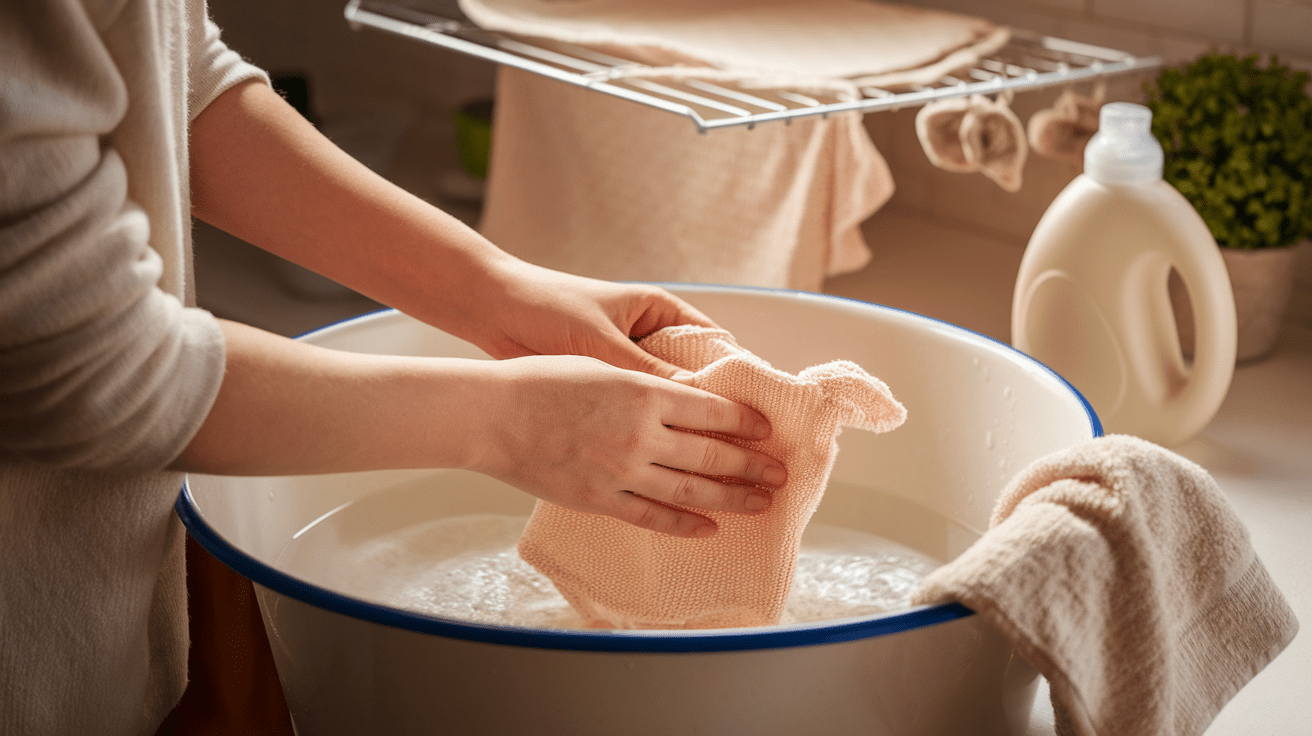
Some baby garments require special attention to preserve their quality and protect fine materials, making hand washing the safest option for certain precious or fragile items in your little one’s wardrobe.
1. When to Hand Wash
Hand-wash items labeled “hand wash only,” fine knits, special occasion outfits, heirloom pieces, and clothing with embellishments like sequins or beading.
Also, consider hand washing very expensive items, such as wool or cashmere and items with fine trims that could snag in a machine.
2. Preparing Your Washing Station
Fill a clean sink or basin with lukewarm water and add a small amount (1 teaspoon) of mild baby detergent. Swirl to create a gentle solution without excessive bubbles. Have a clean towel nearby for drying.
3. Step-by-Step Process
Submerge the garment completely and gently agitate it with your hands. Focus on soiled areas with light rubbing, but avoid wringing or twisting.
For stains, apply a small amount of baby-safe stain remover and gently work it in with your fingertips. Soak heavily soiled items for 15-30 minutes.
4. Rinsing Thoroughly
Drain the soapy water and refill with clean, lukewarm water. Gently swish the garment to remove soap. Repeat until no soap remains—usually 2-3 rinse cycles. Soap residue can irritate a baby’s skin, so thorough rinsing is essential.
5. Drying Fine Items
Press (don’t wring) water out by placing the garment between clean towels. Reshape the item while damp and lay flat to dry on a clean towel away from direct sunlight, which can fade colors and damage fibers.
Special Care for Different Fabrics
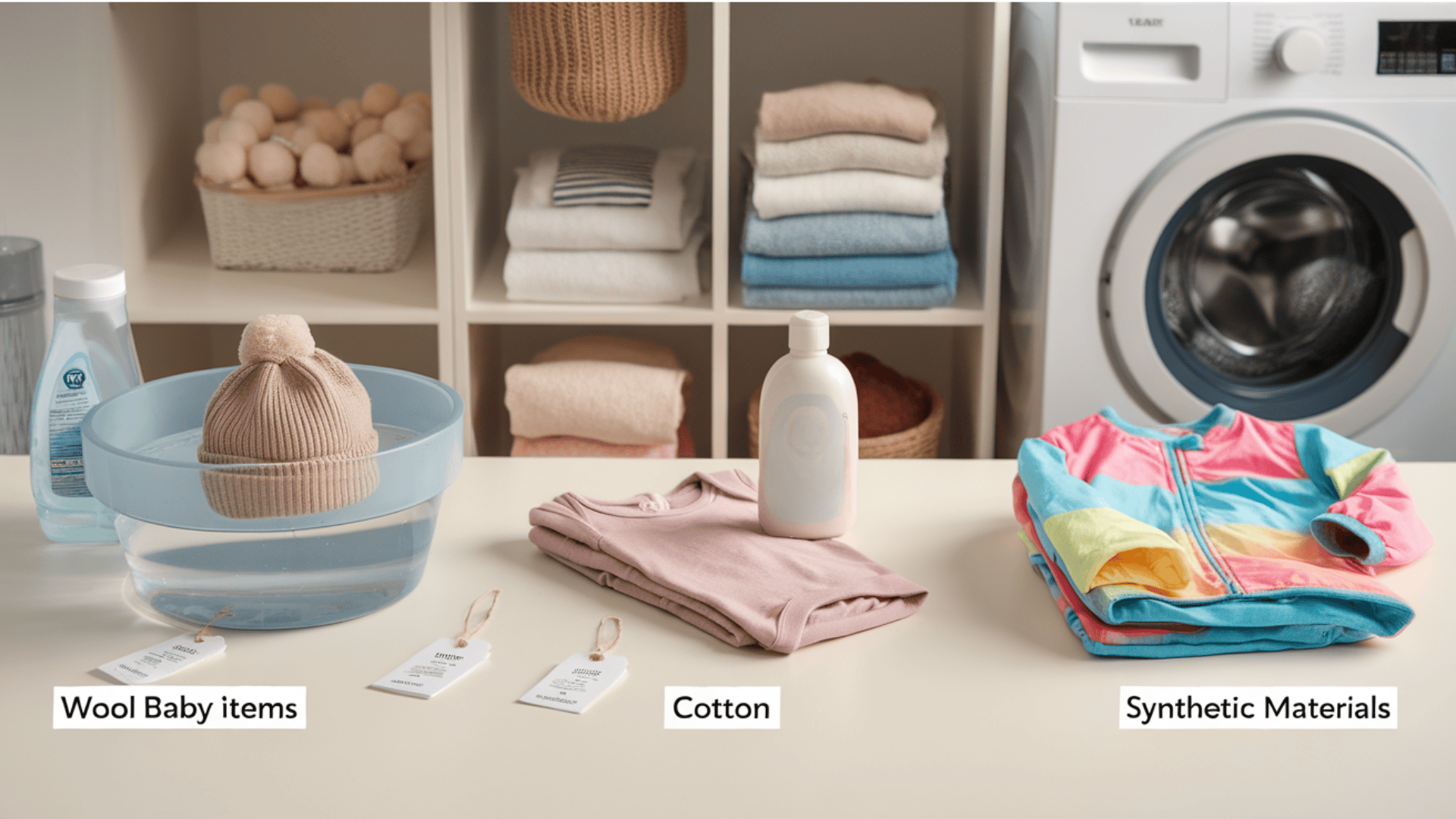
When washing wool baby items, use cold water and wool-specific detergent to prevent shrinking and felting. Hand wash or use your machine’s wool cycle, then reshape and lay flat to dry away from direct heat.
For cotton and organic fabrics, wash in cold to warm water using gentle, plant-based detergents. These natural fibers can typically withstand regular washing but may shrink slightly in hot water or high-heat drying—pre-shrinking new cotton items before first use.
Synthetic materials like polyester and nylon are generally more durable and colorfast. They can be machine-washed in warm water and typically dry quickly.
These fabrics resist wrinkling but can build up static, so consider using wool dryer balls to reduce this effect.
Tackling Baby Stains
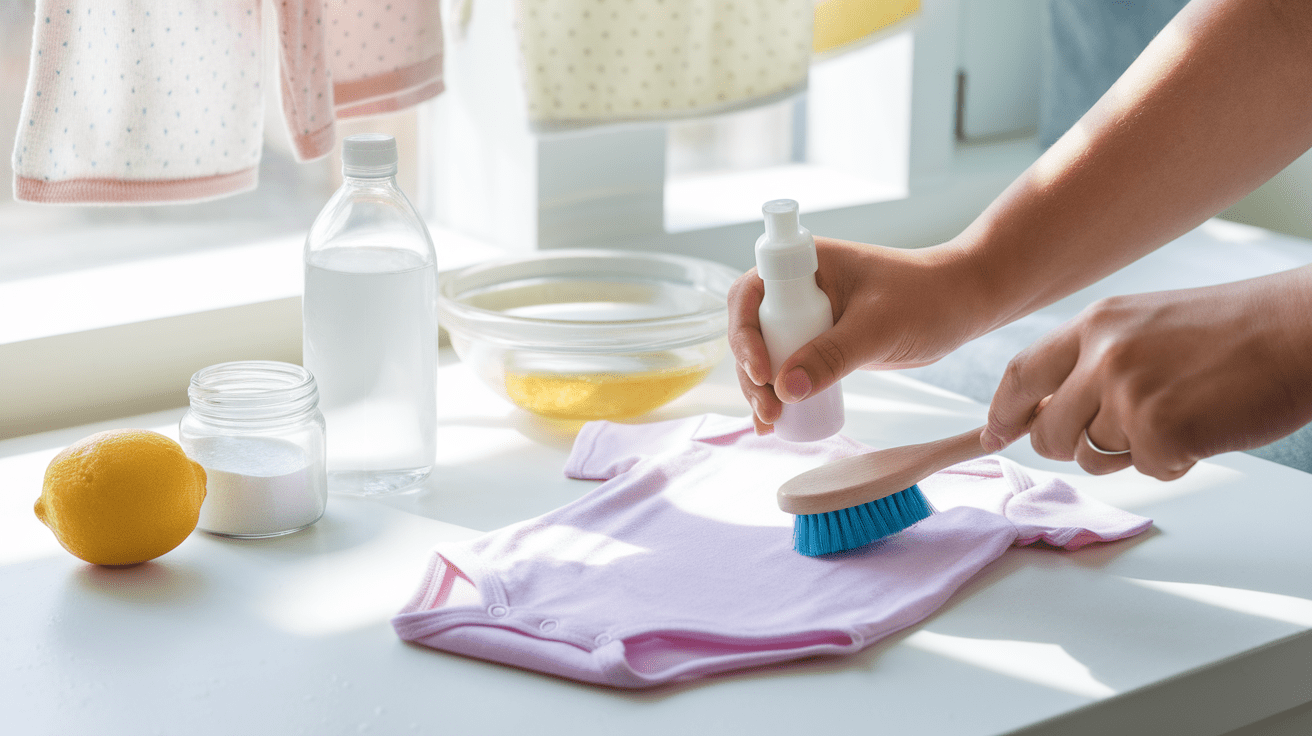
Baby clothes face an onslaught of challenging stains—from protein-based formula and breast milk to the infamous diaper blowout.
Address stains immediately by rinsing with cold water (hot water sets protein stains) and gently rubbing with baby-safe stain remover.
For set-in stains, soak the garment in an oxygen-based bleach solution for several hours before washing. Stubborn stains may require a paste of baking soda and water applied directly to the spot.
Effective pre-treating involves spot-treating stains with a small amount of baby detergent and a soft brush before washing. Allow it to penetrate for 15-30 minutes.
Natural alternatives include sunlight (excellent for organic stains), lemon juice for brightening, and white vinegar for odor elimination and gentle stain lifting.
Disinfecting Baby Clothes
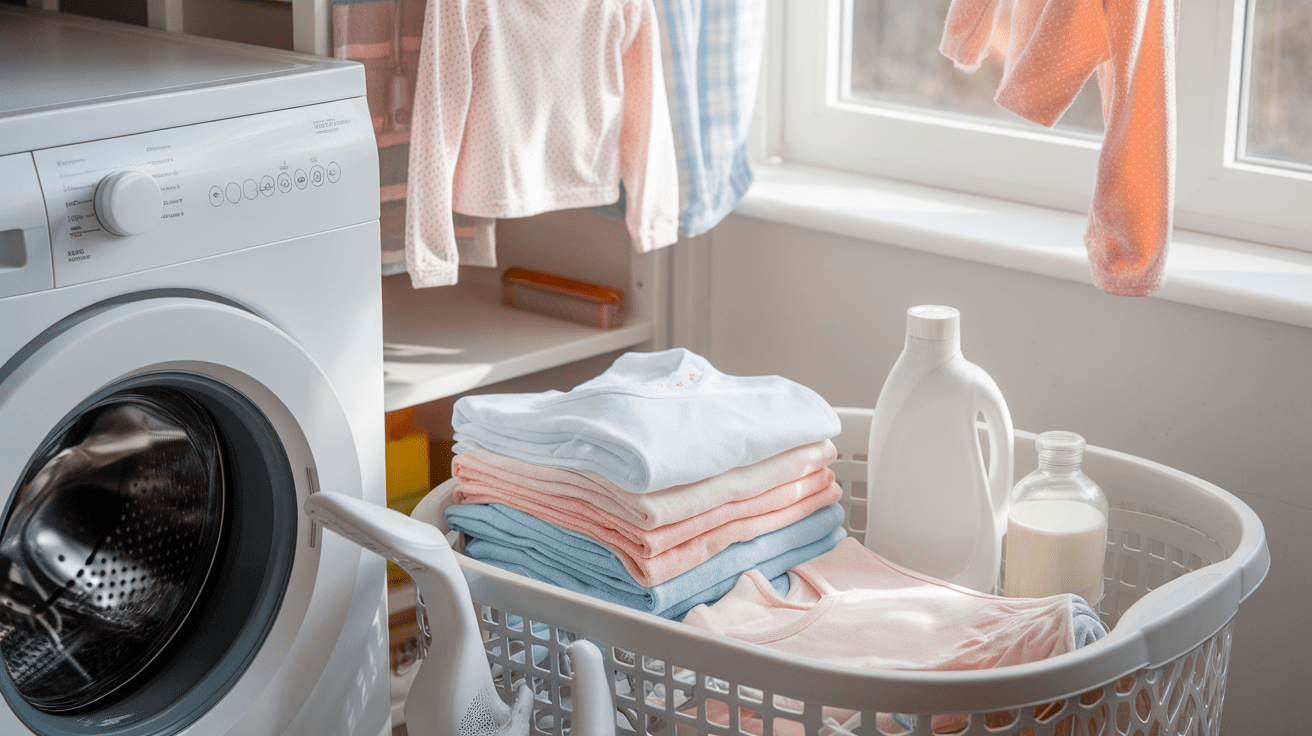
Disinfection becomes necessary when baby clothes are exposed to illness, mold, or particularly soiled with bodily fluids.
Regular washing is sufficient for everyday wear, but targeted disinfection helps during sickness or for secondhand items.
Safe disinfection methods include washing in hot water (60°C/140°F) when fabrics allow, adding oxygen-based bleach for whites and colorfast items, or using the sanitize cycle on your washing machine if available.
For natural alternatives, sunlight provides excellent disinfection—hang clothes to dry in direct sun. White vinegar (1/2 cup per load) offers mild antimicrobial properties while eliminating odors.
Steam cleaning is another effective chemical-free option that kills most bacteria and dust mites without harsh ingredients.
Drying Baby Clothes Properly
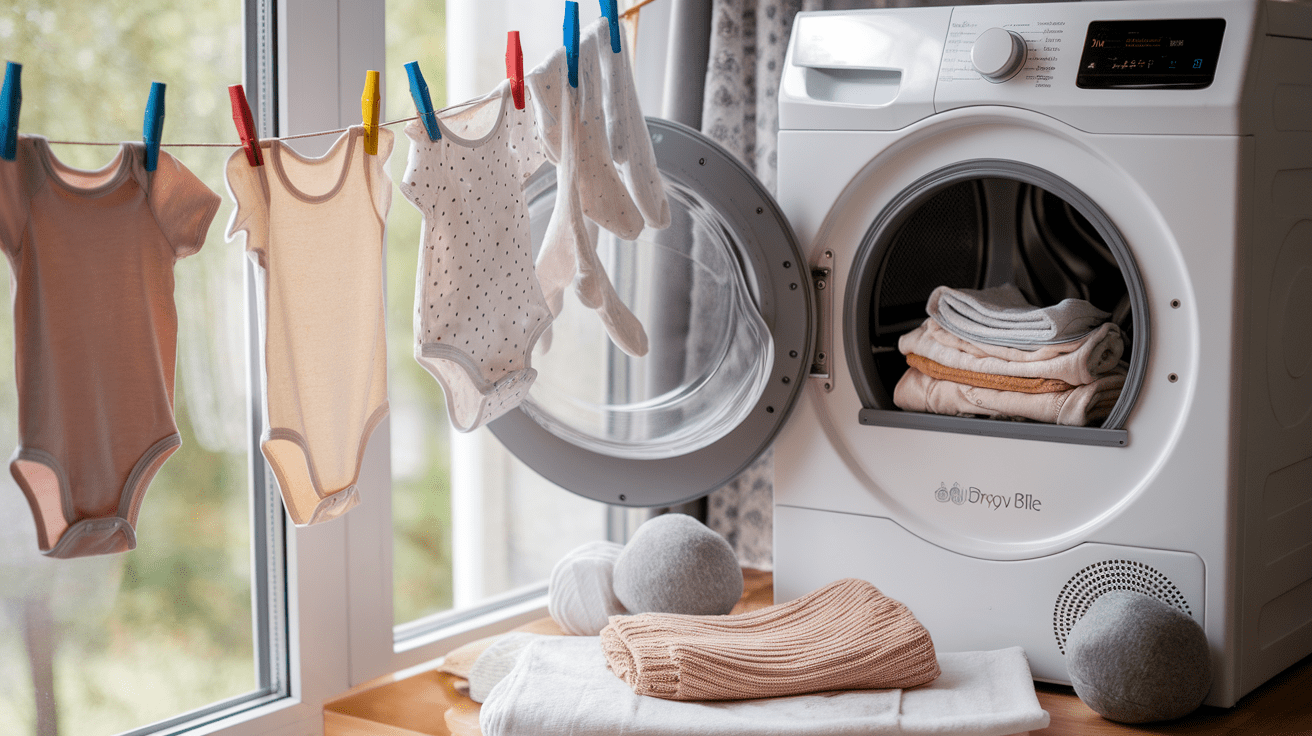
Line drying offers gentler treatment for fine baby clothes, preserving fabric integrity and preventing shrinkage.
It also leverages sunlight’s natural disinfecting and brightening properties. Reserve this method for special items and when time permits.
Machine drying provides convenience but requires careful temperature management. Use low to medium heat settings for most baby clothes to prevent damage to elastic, appliqués, and fabric fibers. High heat should be avoided for all but cotton items that need sanitizing.
To minimize shrinkage, remove clothes while slightly damp and allow them to finish air-drying. This also reduces wrinkles.
For items prone to shrinking, like cotton knits, shape them while damp and lay them flat to dry on a towel.
Storing Clean Baby Clothes
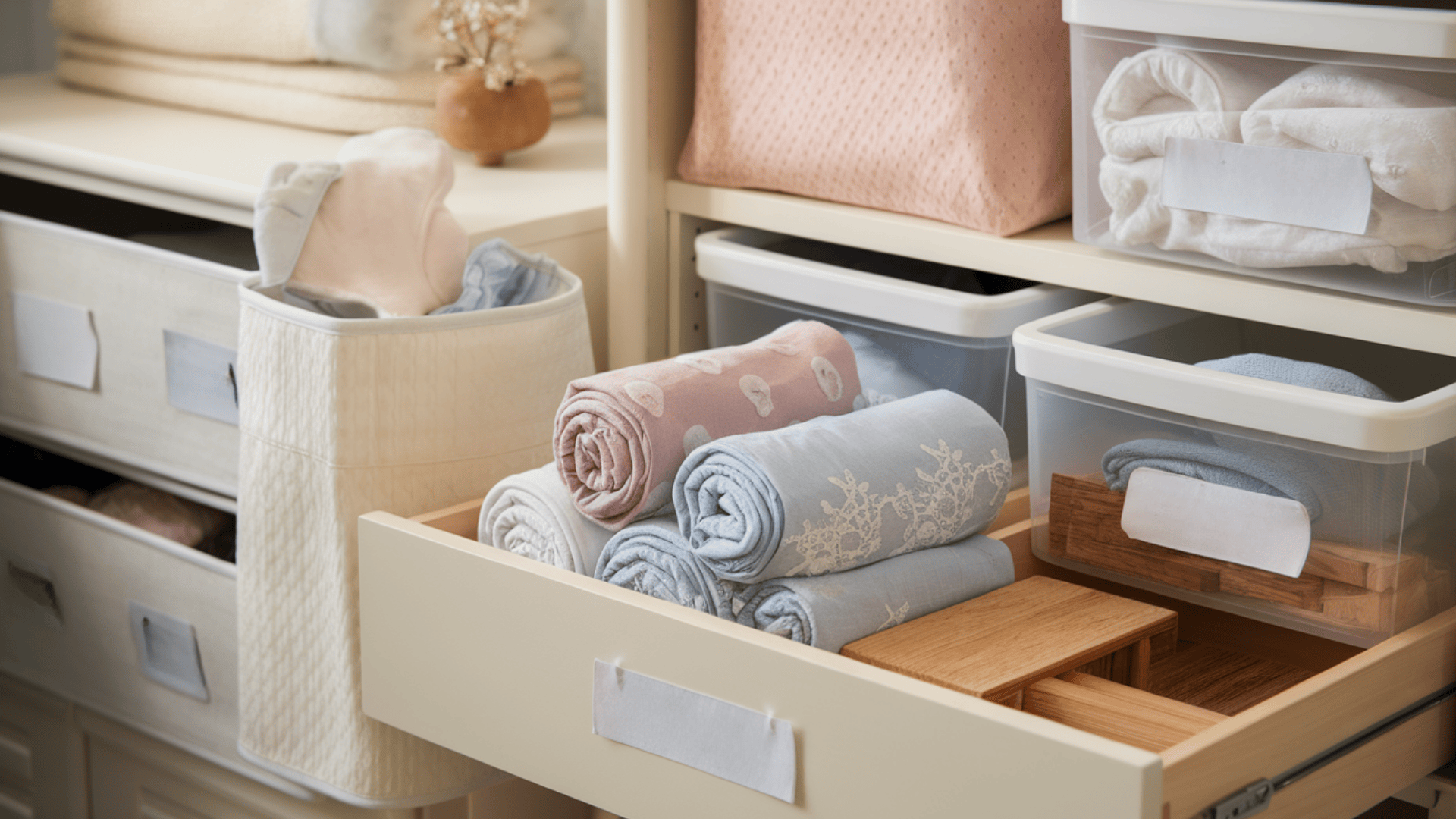
Organize baby clothes by size and type in labeled bins, drawers, or closet dividers to quickly find what you need during hectic days. Rolling onesies instead of folding saves space and reduces wrinkles.
Clean clothes should be stored in closed drawers, breathable cotton bins, or vacuum-sealed bags for long-term storage to protect them from dust and allergens.
To repel insects naturally without introducing chemicals, add cedar blocks rather than mothballs.
Prepare for your baby’s growth by creating a separate storage area for upcoming sizes. Sort larger clothes by both size and season, clearly labeling containers with “6M Summer” or “12M Winter.”
Keep a small bin accessible for items your baby is about to grow into, allowing for quick transitions between sizes.
Eco-Friendly Washing Options
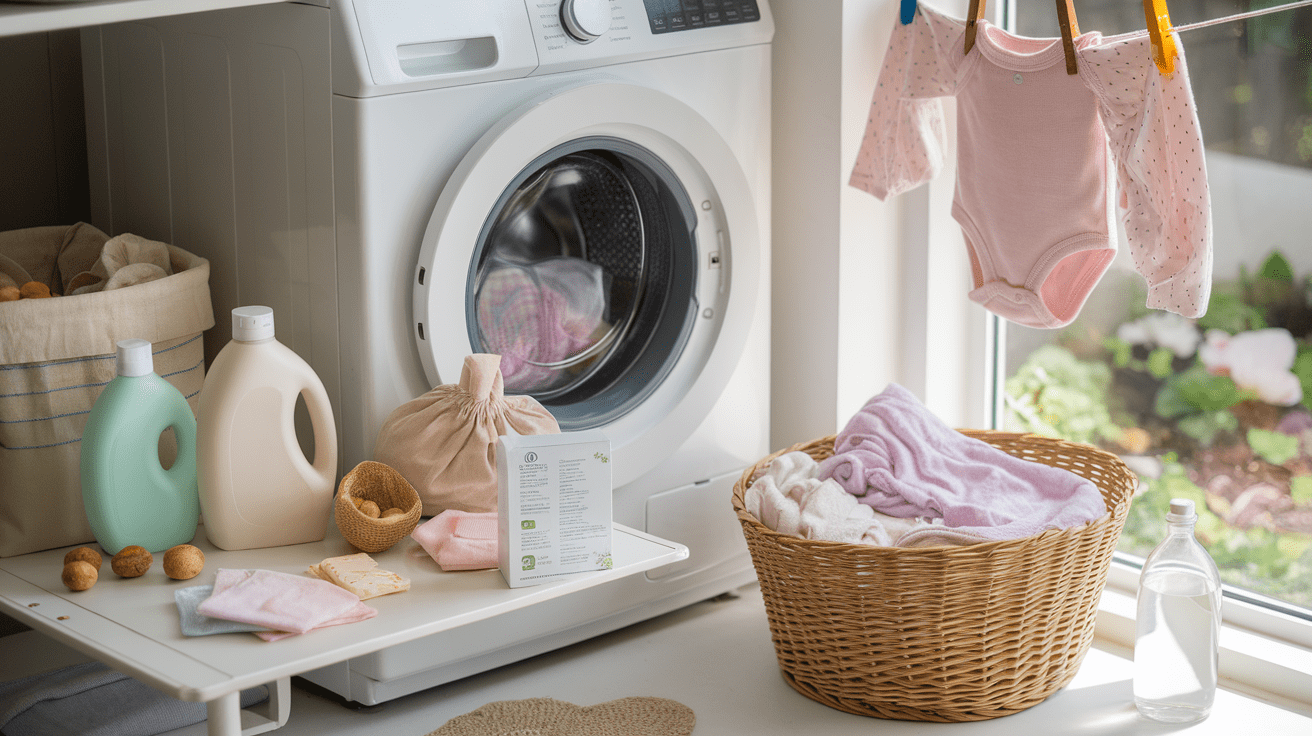
Choose plant-based, biodegradable detergents that are free from phosphates, optical brighteners, and synthetic fragrances.
Look for concentrated formulas with minimal packaging or brands offering refill options to reduce plastic waste. Soap nuts and detergent sheets provide effective cleaning with an even smaller environmental footprint.
Conserve energy and water by washing full loads rather than several small ones. Cold water washing saves up to 90% of the energy used in hot water cycles while still cleaning effectively.
Front-loading machines typically use 40-60% less water than top-loaders and extract more moisture during spinning, reducing drying time.
Maximize efficiency by pre-treating stains to avoid rewashing and using the appropriate water level for your load size. Consider installing a greywater system to repurpose laundry water for garden irrigation.
Line drying eliminates energy use while naturally disinfecting and brightening clothes through sun exposure.
For fabric softening, use white vinegar in the rinse cycle instead of commercial softeners that contain harmful chemicals and microplastics.
Safety Tips and Precautions
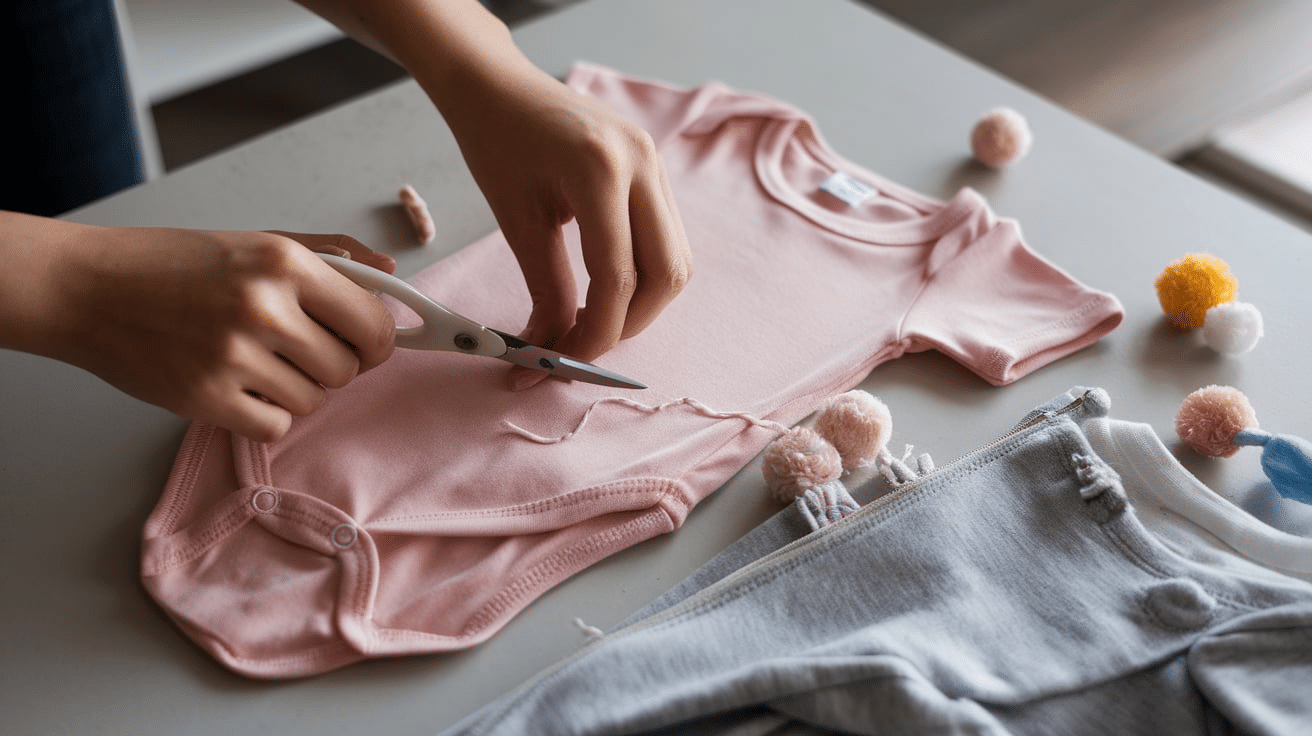
- Inspect clothing regularly for loose buttons, snaps, or decorative elements that could pose choking hazards.
- Avoid drawstrings, especially around the neck, to reduce the risk of strangulation.
- Trim loose threads immediately as they can wrap around fingers, toes, or necks.
- Opt for flame-resistant sleepwear to increase nighttime safety, especially for toddlers.
- Ensure zippers have covers to prevent pinching your baby’s sensitive skin.
- Remove small embellishments like pom-poms or beads that could detach and be swallowed.
Final Words
Armed with these essential techniques for washing baby clothes, you’re now equipped to protect your little one’s sensitive skin while maintaining those adorable outfits.
Remember the fundamentals: pre-wash new items, use baby-safe detergents, separate by color and fabric type, tackle stains immediately, and dry properly to prevent damage.
Creating an efficient laundry routine might take some practice, but don’t let perfect be the enemy of good.
In those early weeks especially, simply getting clothes clean using baby-safe methods is a victory worth celebrating.
As your confidence grows, you’ll develop your rhythm and learn what works best for your family’s needs. The time you invest in properly caring for your baby’s clothes pays off in both skin health and extending the life of those precious tiny garments.
Trust your instincts—you’re doing an amazing job navigating parenthood, laundry challenges, and all!
If you’re interested in more informational content on mothers and babies, feel free to click here and explore other blogs that you might enjoy.
